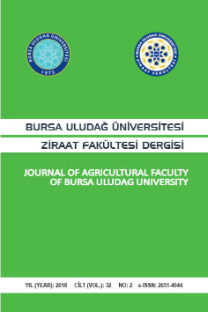Farklı enerji ve protein içeren rasyonların pharaoh bıldırcınlarının besi performansları üzerine etkisi
Bu araştırma, farklı enerji ve protein düzeyine sahip üç rasyonun Pharaoh bıldırcınlarının besi performansı ve karkas randımanı üzerine etkilerini belirlemek amacıyla yürütüldü. Araştırmada toplam 825 adet günlük Pharaoh bıldırcın (Coturnix Coturnix Coturnix) civcivi kullanıldı. Her birinde 275 civciv bulunan 3 ana grup düzenlendi. Grupların herbiri 55 civciv içeren 5 tekrar grubuna ayrıldı. Deneme süresince l, 2 ve 3. grupların metabolik enerji (Kkal/kg) ve ham protein (%) düzeyleri sırasıyla 2900-24; 3200-23; 3200-26.5 olacak şekilde düzenlendi. Deneme 35 gün sürdürüldü. Araştırma sonunda, 3. grubun ortalama canlı ağırlık kazancı 1. gruptan yüksek bulundu (P
Anahtar Kelimeler:
karkas, ham protein, et randımanı, enerji gereksinimleri, yem alımı, bıldırcın, karkas verimi, protein gereksinimi, kümes hayvanları, metabolize olabilir enerji, canlı ağırlık artışı, diyetler, karkas bileşimi
The effects of different energy and protein containing rations on pharaoh quail performance
This study was carried out to determine the effects of three rations containing different energy and protein levels on performance and carcass yield of Pharaoh quails. A total of 825 daily Pharaoh quail chicks (Coturnix Coturnix Coturnix) were used in this experiment. They were divided into 3 groups each containing 275 chicks. Each group was divided into 5 replicate groups containing 55 chicks. During the study, energy and protein (metabolic energy Kkal/kg, crude protein %) levels of groups 1, 2 and 3 were arranged to 2900-24; 3200-23; 3200-26.5 respectively. The experimental period lasted 35 days. At the end of study, avarage body weight gain of group 3 was found higher than group 1 (P<0.001). Feed consumption per one kg body weight gain of groups 1, 2, 3 were determined as 2.93, 2.65, 2.61 kg respectively. There were no statistically difference among the groups and sex in dressing percentage. It is concluded that, metabolic energy and crude protein requirements of Pharaoh quails are higher than levels suggested by NRC (1994) standards for Japanese quails.
Keywords:
carcasses, crude protein, dressing percentage, energy requirements, feed intake, quails, carcass yield, protein requirement, poultry, metabolizable energy, liveweight gain, diets, carcass composition,
___
1.A.O.A.C. Official Methods of Analysis of the Association of Official Analytical Chemists 14th Ed. Inc, Arlington, Virginia, 1984.2.BAYRAM İ, AKINCI Z, BAŞALAN M. Influence of Inclusion of Groundnut Meal on Performance of Growing Quails. Ind. Vet. J. (In Press).
3.DÜZGÜNEŞ O. İstatistik Prensipleri ve Metotları, Ege Üniv. Matbaası, VIII. Baskı, İzmir, 1963.
4.HARTEL H. Relations Between N-Corrected Metabolisable Energy and Nutrient Content of Feeds For Chickens, Archiv Für Gefluegelkunde, 1977; 41: 152-182.
5.KIRKPINAR F, OĞUZ I. Influence of Various Dietary Protein Levels on Carcass Composition in the Male Japanese Quail (Coturnix Coturnix Japonica). British Poult. Sci., 1995; 36: 605-610.
6.KOÇAK Ç. Bıldırcın Üretimi. Ege Zootekni Derneği Yayınları, İzmir, 1985.
7.LEPORE PD, MARKS HL. Protein and Energy Requirements of Growth Selected Lines of Japanese Quail. Poult. Sci., 1968; 47: 1688-1689.
8.NRC. Nutrient Requirements of Poultry. National Academy Press, Washington, D.C., 1994.
9.OLIVERA NTE, SILVA MA, SOARES RT, FONSECA JB, THIEBAUT JTL, FRIDRICH AB, DUARTE RG, TEIXEIRA LV. Energy and Protein Requirements For Male Japanese Quails Reared For Meat Production. Arquivo Brasileiro de Medicina Veterinaria Zootecnia, 2002; 54: 196-203.
10.PARLAT SS, YILDIZ AÖ, YAZGAN O. Japon Bıldırcınlarının Farklı Enerji İçerikli Rasyonlara Tepkisi, II Ulusal Hayvan Besleme Kongresi, 18-20 Eylül 2003, Konya, Sayfa, 208.
11.SARICA M, CAMCI Ö, SELÇUK E. Bıldırcın, Sülün, Keklik, Etçi Güvercin ve Devekuşu Yetiştiriciliği, O.M.Ü. Ziraat Fak. Ders Kitabı, No:10, Samsun, 1998.
12.SARICA M, SOLEY F. Bıldırcınlarda Kesim ve Karkas Özellikleri Üzerinde Bir Araştırma. O.M.Ü. Ziraat Fak. Derg., 1995; 10: 107-116.
13.SELÇUK E, AKYURT İ. Bıldırcın Yetiştiriciliği. TC Tarım ve Köyişleri Bakanlığı Proje ve Uygulama Genel Müdürlüğü Yayınları, Erzurum, 1984.
14.SHANAWAY MM. Quail Production Systems, Çev. Edit. VATANSEVER H. Bıldırcın Üretim Sistemleri, Kardelen Yayınları, Ankara, 2002.
15.SHRIVASTAV AK, PANDA B. Effect of Increasing Calorie-Protein Ratio During Growing Period (4-5 Week) on Dressing Yield and Chemical Composition of Quail Meat. India J. Poult. Sci., 1982; 17: 253-256.
16.SNEDACOR GW, COCHRAN WG. Statistical Methods. 7th ed., The Iowa Univ. Press, Ames Iowa, 1980.
17.SOYSAL Mİ. Bıldırcın Yetiştiriciliği. Hasad Derg., 1998; 14: 42-44.
18.SVACHA A, WEBER CW, REID BC. Lysine, Methionine and Glycine Requirements of Japanese Quail to Five Weeks of Age. Poult. Sci., 1970; 49: 54-59.
19.TORGES HG, WAGNER RM. Mastleistung Schwerer Wachtein in Anhangigkeit Von Alter und Geschlecht. Archiv Für Gefluegelkunde, 1984; 48: 57-65.
20.WEBER CW, REID BL. Protein Requirements of Coturnix Quail to Five Weeks of Age. Poult. Sci., 1976; 46: 1190-1194.
21.ZUCKER H, GRAPP J, PEH J, ZENTZ CH. Erfahrungen Mit Der Japanischen Wachiel (Coturnix Coturnix Japonica) Als Labortler Sowle Einige Ergebnisse Van Nahrstaff Bedarfsuntersuchungen. Tierärtzliche Umschau, 1967; 8: 416-435.
- ISSN: 1301-3173
- Yayın Aralığı: Yılda 2 Sayı
- Başlangıç: 1981
- Yayıncı: Ahmet Akkoç
Sayıdaki Diğer Makaleler
Süt ve süt ürünlerinde aflatoksin $M_1 (AFM_1)$ ve Türkiye'deki durumu
BAŞARAN KARADEMİR, Abdullah DOĞAN, İsmail KAYA
Köpeklerde fertilitenin değerlendirilmesinde seminal plazma içeriğinin önemi
BAYAZIT MUSAL, GÜNEŞ ERDOĞAN, Bilginer TUNA
Memeli embriyonlarının kriyoprezervasyonu
Akut ve kronik böbrek yetmezliğine sahip köpeklerde lipid profilinin değerlendirilmesi
Sezgin ŞENTÜRK, Meltem ÇETİN, Esin GÖLCÜ, DUYGU UDUM KÜÇÜKŞEN
Sakarya yöresi süt sığırlarında Neosporosis caninum
Taraneh ÖNCEL, Gülay BIYIKOĞLU
Yarış atlarında asit-baz dengesi ve elektrolitler
ÜLGEN GÜNAY, Zekeriya NUR, İBRAHİM DOĞAN, Burcu BAŞPINAR, M. Kemal SOYLU
